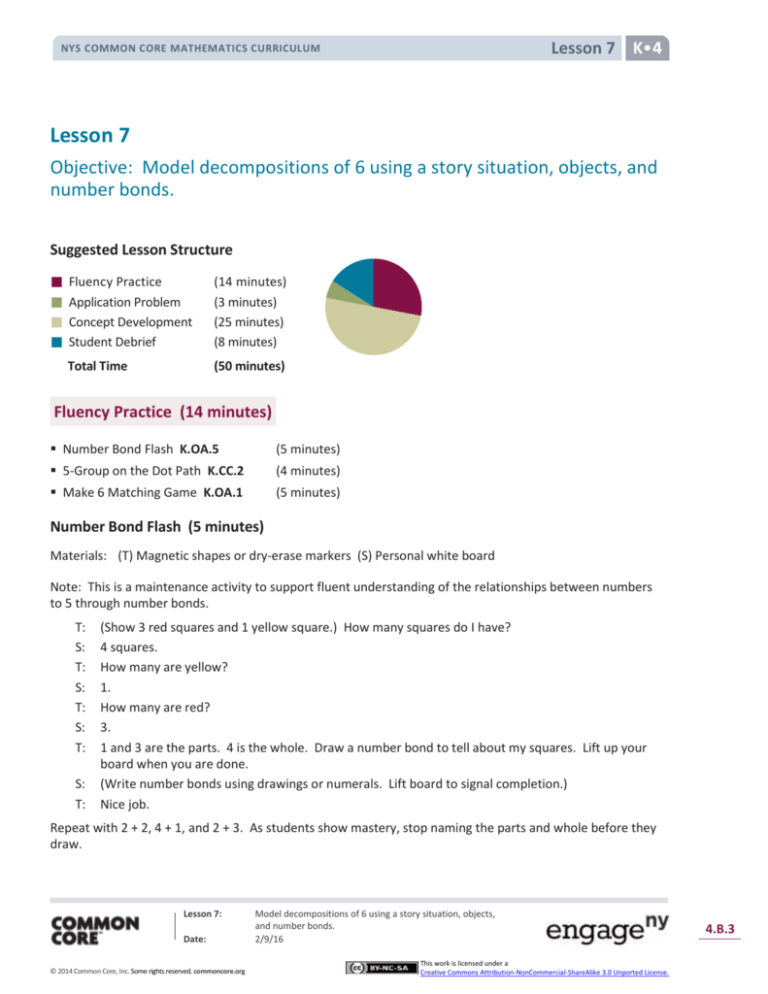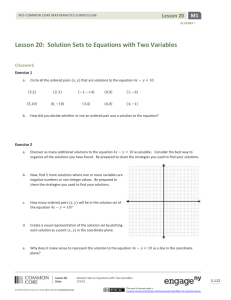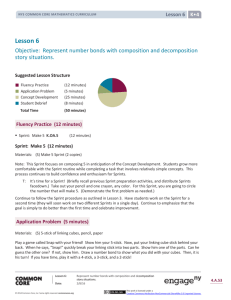
Lesson 7 K
NYS COMMON CORE MATHEMATICS CURRICULUM
Lesson 7
Objective: Model decompositions of 6 using a story situation, objects, and
number bonds.
Suggested Lesson Structure
Fluency Practice
Application Problem
Concept Development
Student Debrief
Total Time
(14 minutes)
(3 minutes)
(25 minutes)
(8 minutes)
(50 minutes)
Fluency Practice (14 minutes)
Number Bond Flash K.OA.5
(5 minutes)
5-Group on the Dot Path K.CC.2
(4 minutes)
Make 6 Matching Game K.OA.1
(5 minutes)
Number Bond Flash (5 minutes)
Materials: (T) Magnetic shapes or dry-erase markers (S) Personal white board
Note: This is a maintenance activity to support fluent understanding of the relationships between numbers
to 5 through number bonds.
T:
S:
T:
S:
T:
S:
T:
S:
T:
(Show 3 red squares and 1 yellow square.) How many squares do I have?
4 squares.
How many are yellow?
1.
How many are red?
3.
1 and 3 are the parts. 4 is the whole. Draw a number bond to tell about my squares. Lift up your
board when you are done.
(Write number bonds using drawings or numerals. Lift board to signal completion.)
Nice job.
Repeat with 2 + 2, 4 + 1, and 2 + 3. As students show mastery, stop naming the parts and whole before they
draw.
Lesson 7:
Date:
© 2014 Common Core, Inc. Some rights reserved. commoncore.org
Model decompositions of 6 using a story situation, objects,
and number bonds.
2/9/16
This work is licensed under a
Creative Commons Attribution-NonCommercial-ShareAlike 3.0 Unported License.
4.B.3
Lesson 7 K
NYS COMMON CORE MATHEMATICS CURRICULUM
5-Group on the Dot Path (4 minutes)
Materials: (S) Dot path (Fluency Template 1) placed inside a personal white
board
Note: This activity helps students gain flexibility in grouping 5 and starting
to count on from 5 pictorially. This will help students think about 6 as 5 and
1 more in preparation for the day’s lesson.
T:
S:
T:
S:
T:
S:
T:
S:
T:
S:
T:
S:
Dot Path
Touch and count the dots on your dot path.
1, 2, 3,…10.
What do you notice about the dot path?
There are 10 dots. There are two different colors of dots. The color changes after 5.
Yes. I’m going to ask you to circle a group of dots. Use
the color change after 5 to count and circle them as
fast as you can. Ready? Circle 5.
NOTES ON
(Circle a group of 5 dots.)
MULTIPLE MEANS
How did you do that so fast?
OF REPRESENTATION:
I just circled all the light ones, and I knew it was 5.
Counting on is a Level 2 method for
solving single-digit addition and
Erase. Get ready for your next number. Circle 6.
subtraction problems. Students are
(Circle a group of 6 dots.)
not expected to use this method until
How did you count 6?
first grade. Those working above
grade level may be ready to count on
I counted all of the dots until I got to 6. I counted 1
in this simplified context. If students
more than 5.
are starting to count on, invite them
to talk or write about their thinking.
If students are starting to count on, let them share their
thinking with the class. Continue the process with numbers to
10. Deviate from a predictable pattern as students show
mastery.
Make 6 Matching Game (5 minutes)
Materials: (S) Matching game cards 0–6 (1 picture of each quantity per pair), (Fluency Template 2)
Note: Reviewing the hidden partners of 6 helps students recall familiar relationships between numbers 1–6,
preparing them to depict those relationships using the number bond model.
1. Shuffle and place the cards face up from 0 to 6 in one equal row.
2. Partner A chooses 2 cards that make 6.
3. If the total of the numbers on both cards is 6, then she collects both cards. If not, then Partner A puts
them back in their place.
4. Repeat for Partner B.
Have early finishers repeat the game, but this time put the cards in order from 0 to 6 to see if they notice that
they can take the cards from either end: 0 and 6, 1 and 5, etc.
Lesson 7:
Date:
© 2014 Common Core, Inc. Some rights reserved. commoncore.org
Model decompositions of 6 using a story situation, objects,
and number bonds.
2/9/16
This work is licensed under a
Creative Commons Attribution-NonCommercial-ShareAlike 3.0 Unported License.
4.B.4
Lesson 7 K
NYS COMMON CORE MATHEMATICS CURRICULUM
Application Problem (3 minutes)
Materials: (T) Bell or other gentle noisemaker or instrument
Close your eyes and count each time that I clap. (Clap 5 times; pause, and then clap 1 more time.) Open your
eyes. How many claps did you hear? (Allow time for students to answer.) Let’s do it 1 more time. (Repeat.)
How many claps did you hear? What is 1 more than 5?
Repeat this exercise several times, using claps and instrument sound parts of 4 and 2, 3 and 3, 2 and 4, and 1
and 5.
Now, try the game with your partner! Take turns clapping different number partners for 6.
Note: This exercise helps the students to focus on the decomposition of 6 in preparation for today’s lesson.
Concept Development (25 minutes)
Materials: (S) Linking cube 5-stick, loose cubes, personal white
board
Put the loose cubes in between students so there are enough
for each student to choose 1 additional cube.
Draw a blank number bond on the board in any configuration.
T:
T:
T:
S:
T:
S:
T:
S:
T:
A NOTE ON
MULTIPLE MEANS
OF REPRESENTATION:
To help English language learners
follow the story and lesson, show
pictures of a squirrel and nuts with
the words squirrel and nuts on it. This
encourages them to follow along and
respond to questions.
I’m going to tell you a story. Show me the story with
your cubes as I go.
A squirrel collected 6 nuts for the fall. With your
cubes, show me a linking cube stick as long as her 6
nuts. Begin with your 5-stick.
She buried 4 nuts in the ground and stored the other 2 nuts in a tree. Break your stick and hold up
the piece that shows me how many nuts were in the ground. How many?
(Hold up a 4-stick.) 4.
Hold up the stick that shows how many nuts were stored in the tree.
(Hold up a 2-stick.) 2.
Yes! She took her 6 nuts and made sets of 4 and 2. Let’s show what the squirrel did in this number
bond. (Guide students to help you place the numbers representing the whole and the parts in the
number bond.) Our number bond shows us that 6 is the same as…?
4 and 2.
(Write 6 = 4 + 2.) 6 is 4 and 2.
Lesson 7:
Date:
© 2014 Common Core, Inc. Some rights reserved. commoncore.org
Model decompositions of 6 using a story situation, objects,
and number bonds.
2/9/16
This work is licensed under a
Creative Commons Attribution-NonCommercial-ShareAlike 3.0 Unported License.
4.B.5
Lesson 7 K
NYS COMMON CORE MATHEMATICS CURRICULUM
T:
S:
T:
MP.2
T:
S:
T:
S:
T:
Put your 6-sticks back together. Does anyone know another way the squirrel can divide her nuts?
She can put 3 in the tree and bury the other 3.
Show me with your linking cube sticks what that looks like. Hold them up! (Check for
understanding.)
Help me to make a new number bond for the new story. (Create a new blank number bond in a
different orientation.) Do we still put the 6 in the place for the whole?
Yes. She still has 6 nuts altogether.
What did change?
The parts in the other circles. We have to change the 4 and the 2 for the 3s.
(Demonstrate.) Thank you! You are right. I’ll write it the special math way, too. (Write 6 = 3 + 3
underneath the number bond.) 6 is the same as 3 and 3. Is there another way she could have split
up her nuts?
Continue exercise several times with other partners for 6, each time asking the students to model the
decomposition with the linking cubes; each time, they will create new number bonds and corresponding
equations.
T:
T:
Now, draw the 6 nuts on your white board. With your partner, take turns
deciding how the squirrel should store her nuts. Circle the nuts that she
will bury, and draw a box around the nuts that she will hide in the tree.
Draw a number bond to show how the squirrel stored them each time.
Wow! You found a lot of different ways to make 6. The squirrel will be
happy. How many different ways will you discover? (Allow time for
discussion.) Let’s review them, and then do some more work with 6 in our
Problem Set. (Review the different number bonds, using the language
“6 is…” We can omit the partners including zero from the written list to
keep the list more manageable.)
Problem Set (10 minutes)
Students should do their personal best to complete the Problem Set within the allotted time.
Note: Encourage students to find many decompositions of 6 in the birds: 1 facing left and 5 facing right, 2
finches and 4 ducks, 3 white and 3 shaded, 4 big and 2 small, or, for advanced students, 2 big ducks, 2 small
ducks, and 2 big finches. Add a part to the number bond if students see a combination with three parts.
Student Debrief (8 minutes)
Lesson Objective: Model decompositions of 6 using a story situation, objects, and number bonds.
The Student Debrief is intended to invite reflection and active processing of the total lesson experience.
Invite students to review their solutions for the Problem Set. They should check work by comparing answers
with a partner before going over answers as a class. Look for misconceptions or misunderstandings that can
be addressed in the Debrief. Guide students in a conversation to debrief the Problem Set and process the
lesson.
Lesson 7:
Date:
© 2014 Common Core, Inc. Some rights reserved. commoncore.org
Model decompositions of 6 using a story situation, objects,
and number bonds.
2/9/16
This work is licensed under a
Creative Commons Attribution-NonCommercial-ShareAlike 3.0 Unported License.
4.B.6
Lesson 7 K
NYS COMMON CORE MATHEMATICS CURRICULUM
Any combination of the questions below may be used to lead the discussion.
Share with a partner how you sorted the birds.
Did your partner sort differently than you?
Look with a partner at the numbers you put in
both of your number bonds. Which numbers are
the same? Why? Which numbers are different?
Why?
When I told my story, how did you know which
number to put in which circle in the first number
bond?
How did the number bond change when you split
up the squirrel’s nuts in different ways?
Did the total number of nuts ever change?
What are some of the ways you found to make 6?
Lesson 7:
Date:
© 2014 Common Core, Inc. Some rights reserved. commoncore.org
Model decompositions of 6 using a story situation, objects,
and number bonds.
2/9/16
This work is licensed under a
Creative Commons Attribution-NonCommercial-ShareAlike 3.0 Unported License.
4.B.7
NYS COMMON CORE MATHEMATICS CURRICULUM
Name
Lesson 7 Problem Set K
Date
Look at the birds. Make 2 different number bonds. Tell a friend about
the numbers you put in one of the bonds.
Color some squares green and the rest yellow. Write numbers in the bonds
to match the colors of your squares.
Lesson 7:
Date:
© 2014 Common Core, Inc. Some rights reserved. commoncore.org
Model decompositions of 6 using a story situation, objects,
and number bonds.
2/9/16
This work is licensed under a
Creative Commons Attribution-NonCommercial-ShareAlike 3.0 Unported License.
4.B.8
NYS COMMON CORE MATHEMATICS CURRICULUM
Name
Lesson 7 Homework K
Date
Look at the presents. Make 2 different number bonds. Tell an adult about
the numbers you put in the number bonds.
On the back of your paper, draw 6 presents and sort them into 2 groups.
Make a number bond and fill it in according to your sort.
Lesson 7:
Date:
© 2014 Common Core, Inc. Some rights reserved. commoncore.org
Model decompositions of 6 using a story situation, objects,
and number bonds.
2/9/16
This work is licensed under a
Creative Commons Attribution-NonCommercial-ShareAlike 3.0 Unported License.
4.B.9
NYS COMMON CORE MATHEMATICS CURRICULUM
Lesson 7 Fluency Template 1 K
dot path
Lesson 7:
Date:
© 2014 Common Core, Inc. Some rights reserved. commoncore.org
Model decompositions of 6 using a story situation, objects,
and number bonds.
2/9/16
This work is licensed under a
Creative Commons Attribution-NonCommercial-ShareAlike 3.0 Unported License.
4.B.10
NYS COMMON CORE MATHEMATICS CURRICULUM
Lesson 7 Fluency Template 2 K
matching game cards
Lesson 7:
Date:
© 2014 Common Core, Inc. Some rights reserved. commoncore.org
Model decompositions of 6 using a story situation, objects,
and number bonds.
2/9/16
This work is licensed under a
Creative Commons Attribution-NonCommercial-ShareAlike 3.0 Unported License.
4.B.11
NYS COMMON CORE MATHEMATICS CURRICULUM
Lesson 7 Fluency Template 2 K
matching game cards
Lesson 7:
Date:
© 2014 Common Core, Inc. Some rights reserved. commoncore.org
Model decompositions of 6 using a story situation, objects,
and number bonds.
2/9/16
This work is licensed under a
Creative Commons Attribution-NonCommercial-ShareAlike 3.0 Unported License.
4.B.12










